Cómo planificar y realizar un seguimiento de eventos en juegos móviles
En una etapa de su carrera comenzó a preocuparse por los datos. Decides que quieres saber qué están haciendo tus jugadores, por lo que comienzas a realizar un seguimiento de los eventos del juego. Realizas un seguimiento de todo. ¡Con una ráfaga de código, tu aplicación envía eventos de seguimiento para cada combinación de cartas, movimiento, efecto de hechizo y estadística de batalla!
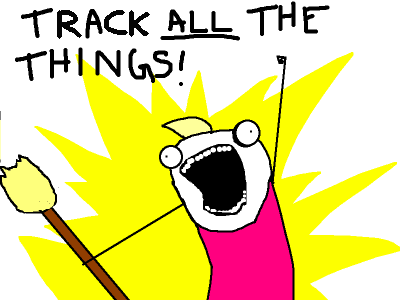
Date una palmadita en la espalda, has creado terabytes de basura.
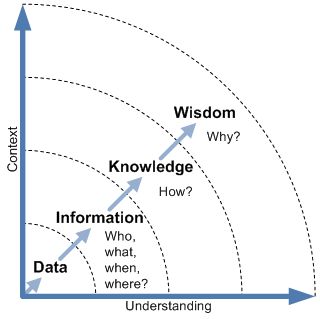
“ Los datos no son información, la información no es conocimiento, el conocimiento no es comprensión, la comprensión no es sabiduría.” Clifford Stoll, físico
Los datos recopilados sin motivo son solo datos. Para poder tomar decisiones informadas necesitas contexto y sólo entendiendo las intenciones de tu jugador empezarás a estar informado. Hay muchas similitudes entre los juegos móviles y, por lo tanto, existen algunas métricas muy estándar que puedes observar. Hemos creado un plan de seguimiento simple que puede utilizar para comenzar.
Plan de seguimiento móvil gratuito para jugar
Un plan de seguimiento es el primer paso para obtener información útil. Úselo como guía para ayudar a todo su equipo a diseñar y crear eventos. Siéntete libre de hacer una copia y personalizarla como mejor te parezca. La sección de código de la derecha supone que estás usando FB Analytics y Unity, pero esto se puede adaptar fácilmente o simplemente omitir. Puedes abrir la plantilla haciendo clic en la imagen a continuación

El plan se basa en tres ideas y las aplica a los juegos móviles.
- Modelo GQM (objetivo, pregunta, métrica) – Wikipedia
- Marketing pirata – 500Hats – Dave McClure
- MVT (seguimiento mínimo viable): pila de crecimiento móvil
El modelo GQM establece el orden correcto para pensar en sus eventos. Siempre es necesario tener un objetivo en mente y luego hacer una pregunta que pueda representarse como una métrica. El marketing pirata le ofrece una manera de pensar fácilmente en 5 objetivos importantes de alto nivel que son importantes para el marketing y el crecimiento de todos los juegos móviles gratuitos. MVT proporciona un marco para centrarse en crear los eventos correctos en el orden correcto.
Juntas, estas metodologías pueden ayudarle a planificar la menor cantidad de eventos valiosos. Cuando una aplicación o juego es joven, es más importante comprender qué impulsa a los usuarios a convertirse en pagadores . La conversión, o la falta de conversión, acaba con más aplicaciones que la baja retención. Si no puedes ganar dinero con tu juego, no tienes un producto gratuito viable.
Puede utilizar el plan como una herramienta de planificación pura o puede utilizarlo para ayudar a realizar un seguimiento de la implementación de los eventos en una aplicación. El plan incluye los eventos básicos que la mayoría de los juegos necesitarían para tomar decisiones de marketing simples. Como cada juego es diferente, tú decides crear objetivos y preguntas que sean específicas para tu juego.
Preguntas de diseño

Using the GQM model you first set a goal for the game. Goals can be very specific or very general, but all apps face similar problems when they are starting out, they lose users and users don’t spend any money. Dave McClure’s Pirate Marketing provide 5 large goals that, if perfected, will drive high growth for your app. These are commonly referred to as AARRR. Say it with a swagger and cutlass in hand! ☠️
A – Activation – getting people into your game.
A – Activity –getting people to use your game.
R – Retention – getting people to come back to your game.
R – Referral – getting people to talk about your game.
R – Revenue – getting people to spend money in your game.
Each category provides a clear goal for your app. You want to encourage more actions in eachcategory and you want to know why some actions are better than others. Setting goals for your core gameplay should focus on what is driving players to play my core loop more?
After choosing a clear goal fro a category such as Activity, a common question might be “where do players spend most of their time?”. Now, pause a second. WHY have you have settled at this question? Is it that you feel you already know the answer, “People spend most of their time fighting!” (feeding a bias) or is it “Fighting leads to higher conversions,people should fight more!” (improve a KPI).Try to always think of questions in a quantative mannor, where you’re not setting any bias but let the data speak. Perhaps“What actions do people spend most of their time doing?” can reveal some useful information. You could then decide on a set of metrics that work well in your game.
What’s driving your users to convert to payers?
Dave McClure’s Pirate Marketing talkprovides5 good mental anchor categoriesfor most apps and free to play games to focus on. The nature of mobile gaming, ina market which ishighly competitive and effectively commoditized, the Retention category becomes a strong focus for teams to improve. You may want to defer the Referral categoryuntil you have built out and got an app that has a stable and monetizing user base. During soft launch you want to also focus on the FTUE / top of the funnel actions because this will be where most of your users will churn, there is a separate tab on the plan specifically to map out your FTUE. Remember conversion is king and even if you have a high churn rate of say 80% in day 1, if you have a high conversion rate of 5% then you still have a viable free to play product.
To further aid all tracking I suggest you always create an XP system and provide it as a dimension in core tracking events.
XP isone of the best and simplest ways of segmenting your users. XP is an ever increasing metric based only on actions in game. You should always try to include XP as a system in your game, even if you don’t surface it to the player, as it’s so useful for tracking. Using XP levels as a bucket to separate users who have performed a similar number of actions allows you to detect points in game time where your designs start to fail.
The goal of all tracking is never to tell you what to build, it can only tell you how badly you built it as no feature is 100% effective.
Designing a Tracking Event
Let’s take the classic Base, Battle and Build game, Clash of Clans. As a game designer you may want to know the answer to “How often do people win their battles?”
Firstly, we must establish that battling is the critical element in this question. For now we only need to know just enough about the battle from the point of view of the defender and attacker. In Clash of Clans people search many enemies before committing to an attack so the first metric should be a count “enemiesScanned”. Next once an enemy is picked the battle is commences,to answer thequestion we don’t need to know anything about the battle itself such as which troops, how much gold the base contained or what Town Hall level they are, we simply need to know the win or loss rate. Even though this extra information is interesting, stay focussed on your initialquestion for now.
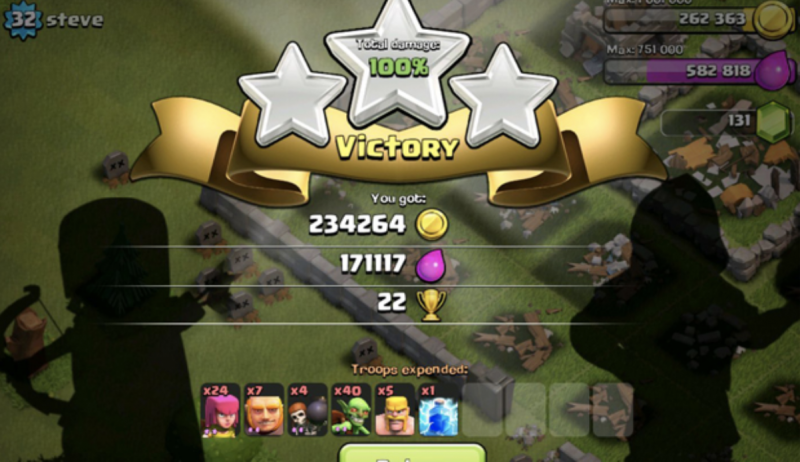
There are 4 outcomes from an attack in Clash, either 1⭐, 2⭐ or 3⭐, or a loss 0⭐. Therefore we need to record these outcomes as “attackOutcome” we may want to go further than this and also send over the “totalDamage” as an integer 0-100. This might give us some useful information in qualifying what type of win it was.
Here’s how it might look on the tracking document:![]()
KPIs and custom KPIs
A developer should now be able to create an event on any platform and you should be able to quickly check how many battles result in a win (1-3 ⭐) or loss (0⭐). To add some more information to the result the enemyScan/Battle ratio could be important as more scans might have a big effect on BattleWin rate. If you feel satisfied that this has answered your initial question, you can now repeat the process to add more depth. Create a new line and add a new question and try to use as many of the same variables as you have already created. You may want to know if battle win rate varies if the player is a Payer/Non-Payer or changes with XP Level? Don’t go wild here or you will suffer from analysis paralysis and then the outcome won’t be useful. It’s always easier to add than to take away, start with the minimum.
To make life simple, games use common KPIs to measure themselves against other games. Many KPIs come as standard and are useful benchmarks, DAU, ARPU, ARPDAU etc. Standard KPIs are a great way of comparing games with each other. However, if your game does not fit within normal ranges, you don’t always need to worry. Your game might excel at some KPIs but not others and you should capitalize on that. If all your KPIs are low, you will have a hard time building them back up and you might want to Kill your Project.
 Related ReadGDC Europe 2014 : “The Art of Killing Games”In Industry Market TrendsAdam Telfer
Related ReadGDC Europe 2014 : “The Art of Killing Games”In Industry Market TrendsAdam Telfer
Creating a KPI target will allow you to aim for something with your tracking. Coming up with the target requires some research (Adjust Mobile Measurement Benchmark Report) for your games genre as each can vary wildly. We’ve also seen many benchmark metrics drop over the years as competition on the app store gets more fierce.
You can and should set your own custom KPIs. These are measures that are specific and matter greatly to your game. When creating a KPI try to think of it as a number that is critical to the well being of my game or users. You can then start to measure and improve it by adding features that help or communicate these functions to your players. Uncommon but generic Events/KPIs that I find helpful are:
- % Tutorial Complete – how many people get to tutorial complete event?
- Completed Views per DAU – (video ad monetisation)
- Min,Max,Median Rounds to complete – (level, world, track, mission)
- 1st gem purchase – what did a user buy after their first IAP?
- Playtime Tracking – count of total number of game minutes inside your app?
- Sources/Sinks – Which actions are providing most currency and most spend in app?
Every game is different but usually when you playtest or watch other people play your game you will notice points where people “get it” or moments of joy where every tester got really excited and wanted to play more or play further. When coming up with a KPI talk with your team and be quite limiting initially. Work hard to establish which custom KPI will help with the project in the next 2 weeks, not one that you think you’ll need in the distant future.
A Good Dashboard
Displaying your data in a simple format is the next step. There are a number of different dashboards you can use or create and many services that provide them. It’s a choice of preference which analytics provider or dashboard you use as they don’t need to be from the same company. The best companies try to own their own data so that they have flexibility in how it can be presented. This is no small task and so only larger studios with strong revenue should consider building it themselves. Free services do provide good dashboards but are less flexible and you will loose or share direct control over your data.
A Good Dashboard
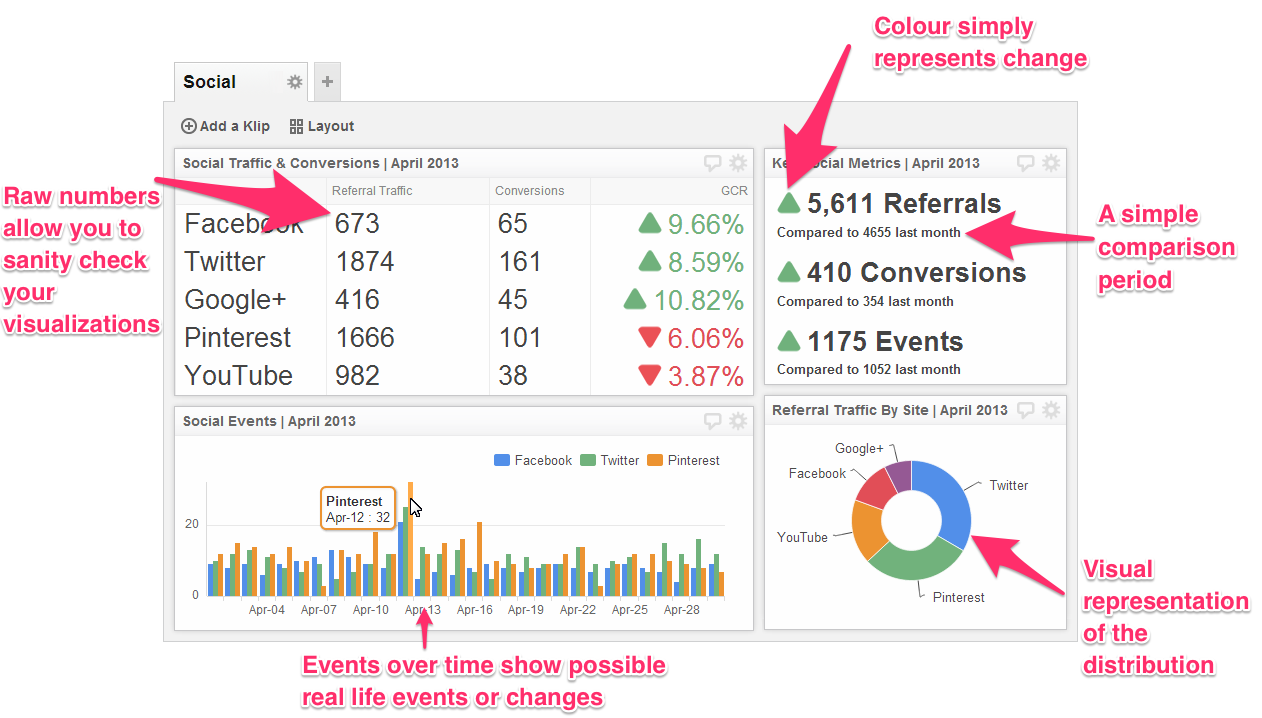
A Bad Dashboard
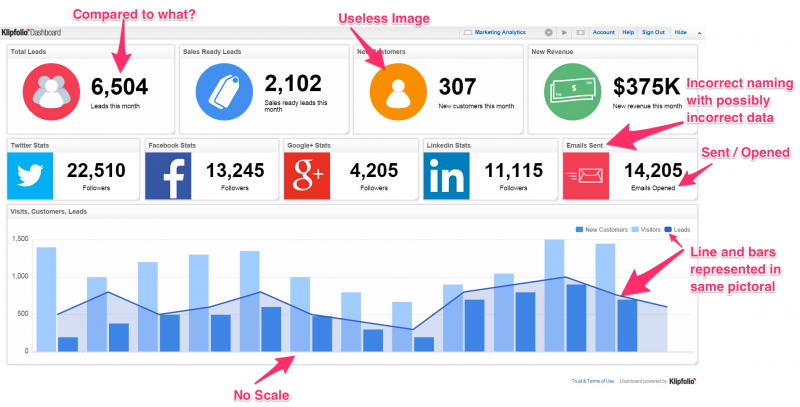
Hay muchas formas de representar datos, pero me gusta intentar tener en cuenta lo siguiente.
- Cada dato necesita un período de comparación, si es posible. Por lo general, 7 días o 30 días funcionarán mejor
- Utilice el color para representar cambios claros en las cifras en comparación con esa cifra de comparación.
- Muestre números reales cuando sea posible para tener una idea de los datos.
- Todo gráfico necesita una escala o un eje.
- Flexibilidad para rotar gráficos y mostrar datos por dimensión compartida principal, como XP o días desde la instalación.
- Tenga paneles de control separados que respondan preguntas o temas específicos en su aplicación. No hay un panel que los gobierne a todos.
Los paneles no necesitan ser bonitos, deben ser informativos y ser buenos para revelar tendencias. No importa lo que le digan sus datos, la tendencia en sus datos es más importante. Si aumenta su retención 1D en un 0,5 % por semana durante las últimas 4 semanas, eso es mucho más valioso que una retención 1D del 32 %. Un panel debe revelar claramente la tendencia y permitirle filtrar o ver estas tendencias en función del tiempo o la versión de la aplicación. El control de versiones es un aspecto importante del desarrollo de software, ya que le permite conocer claramente el código que la gente está viendo. Cualquier software de panel que le facilite filtrar sus vistas por versión le ayudará a ver las tendencias a medida que se desarrolla su software.
Sea consciente de la audiencia de su Panel de control. Algunos paneles y KPI están destinados a equipos de marketing (nivel superior, orientados al dinero), algunos para su equipo de diseño (progresión, abandono, uso de funciones) y algunos para sus desarrolladores (errores, fallas, tiempos de carga) si está creando un panel. asegúrese de verificar que sea la información relevante para la audiencia.
Resumen
Todo el mundo hace mal los análisis la primera vez. Todos creemos que sabemos cómo van a jugar nuestros jugadores, pero una vez que los usuarios reales usan el sistema, las cosas cambian.
Si no se ha sentado y utilizado el enfoque GQM antes, pruébelo. No hay nada peor que unirse a un proyecto y darse cuenta de que todos los datos son basura y que seleccionar y unir tablas será un proceso agotador y doloroso. Comenzar con los puntos de datos más pequeños pero más útiles te permitirá mantenerte concentrado a medida que desarrollas tu juego. El uso de un plan de seguimiento también generará beneficios a largo plazo, ya que podrá revisarlo y recordar por qué intentó rastrear algo en primer lugar.
El seguimiento debe funcionar para el proyecto y, para ello, debe ser fácil y accesible para todos. Creo firmemente en compartir sus datos de forma abierta y gratuita con todos los miembros del equipo, ya que les permite a todos ver cómo su trabajo afecta el producto. Un gran conjunto de paneles es la mejor manera de hacer esto. Todo el proceso de utilizar datos de forma eficaz no es una tarea sencilla en el desarrollo de juegos, pero las mejores empresas los utilizan todos los días y las mejores empresas crean una ventaja competitiva a través de ellos. Empiece poco a poco, céntrese en los eventos importantes y continúe tomando decisiones de diseño informadas.
Leave a Reply